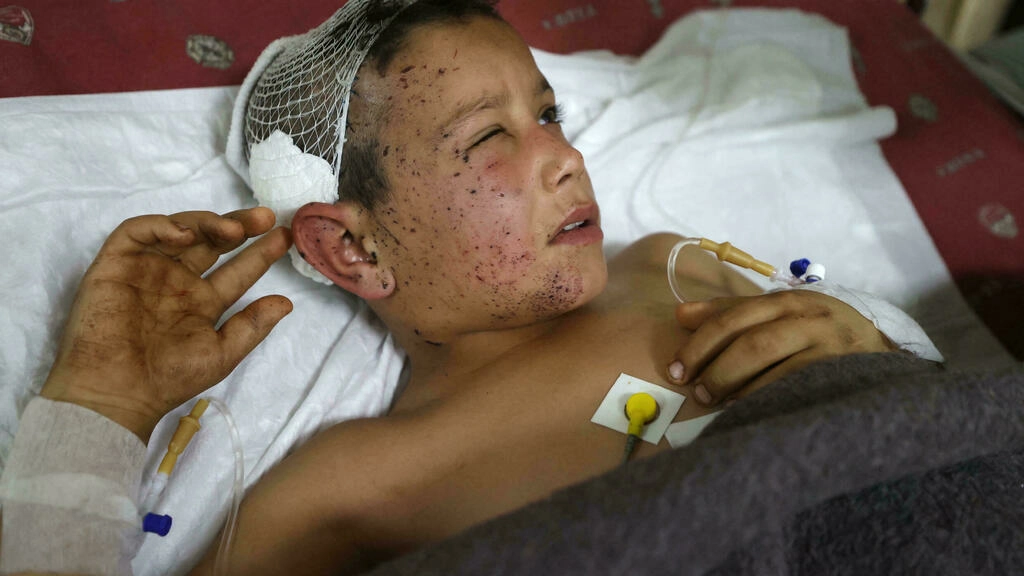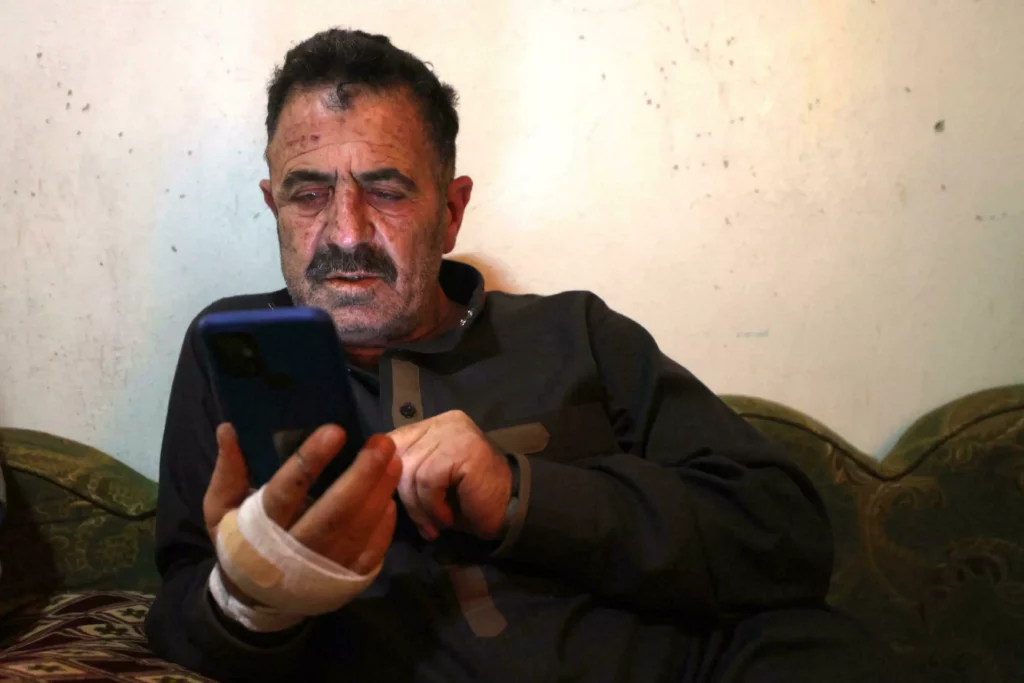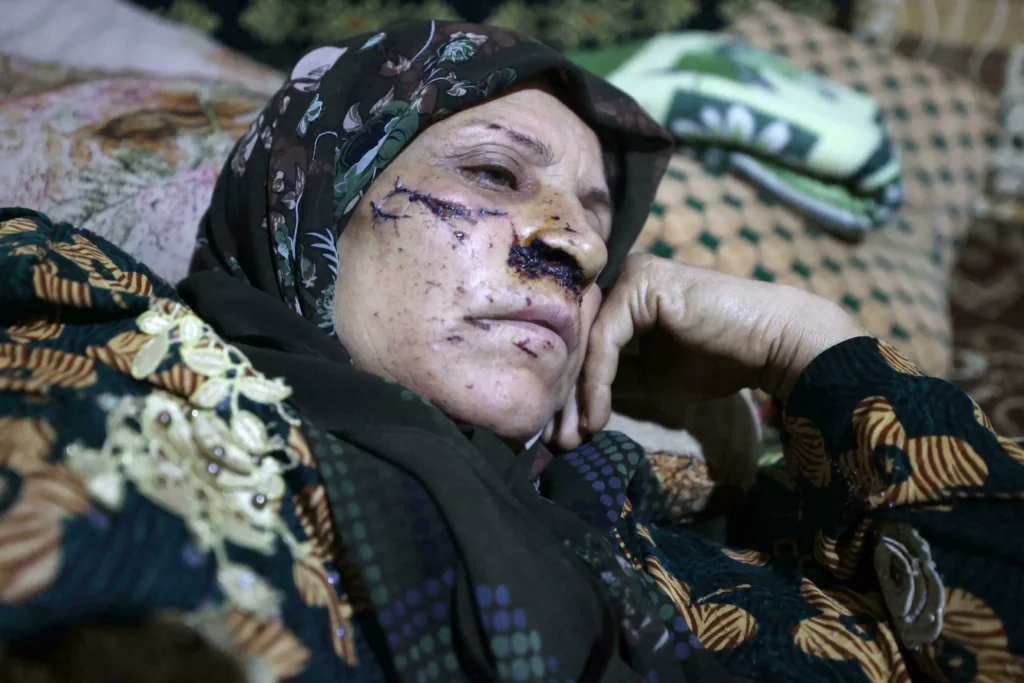‘Pool of Blood’: US Drone Strike Hits Syria Family
SYRIA IN CONTEXT, 13 Dec 2021
AFP | France24 - TRANSCEND Media Service

Nine-year-old Mahmud Qassoum remains in intensive care with a serious head injury after being hit by a US drone strike targeting a suspected Al-Qaeda-linked militant in Syria. OMAR HAJ KADOUR AFP
8 Dec 2021 – Ahmad Qassum was driving home with his family when a US drone targeting an Al-Qaeda-linked militant in Syria struck and left all six of them wounded.
“We came across a motorbike that was driving in front of us, and when I tried to overtake it, I felt a strike hit us,” the 52-year-old displaced Syrian told AFP from his wife’s family home in Idlib province.
Shrapnel from the attack, he said, turned his vehicle into a “pool of blood”.
It wounded his wife and four children, including his nine-year-old son Mahmud who is still in intensive care for a serious head injury.
“I didn’t know who to save first,” Qassum said, recalling the moments immediately after the attack.
Idlib is a region dominated by the Hayat Tahrir al-Sham alliance, which is led by Syria’s former Al-Qaeda affiliate.
For years, a US-led international coalition in Syria and Iraq has conducted air raids that are aimed at jihadists but often kill and maim civilians.
They include a drone strike on Friday that the Pentagon said killed a “senior leader” of the Al-Qaeda-linked Hurras al-Deen faction.
“The initial review of the strike did indicate the potential for possible civilian casualties,” Pentagon spokesperson John Kirby said.
Washington has “launched a civilian casualty assessment report,” he told reporters on Monday.
‘Compensation’
Qassum’s family was driving back to the northern town of Afrin when the strike hit a man riding the motorcycle ahead of them.
They had spent a few days visiting relatives in Idlib, their first such trip in nine months, before their family holiday took a tragic turn.
“What did we do that justifies the Americans bombing us?” Qassum said, one hand wrapped in a bandage, while the other fiddled with a rosary bead.
“We want compensation… and those who did this to us should be held to account.”

The boy’s father, Ahmad Qassoum, says he didn’t know who to save first when shrapnel from the drone strike turned the family car into a “pool of blood”
OMAR HAJ KADOUR AFP
The US-led coalition has disclosed at least 1,417 civilian deaths since it started operations against the Islamic State group (IS) in Syria and Iraq in 2014.
But the actual number of civilians killed is believed to be higher.
A New York Times investigation last month found the US concealed a March 2019 strike near IS’s last Syria bastion of Baghuz that killed 70 people, mainly women and children.
Drawing from confidential documents, interviews with personnel directly involved and officials with top security clearance, the newspaper found the strike “was one of the largest civilian casualty incidents of the war against the Islamic State,” albeit never publicly acknowledged by the US military.
The Pentagon said last month it had opened an investigation into the incident.
‘Victims’
At an Idlib medical facility set up by the Syrian American Medical Society (SAMS), Mahmud was lying on a hospital bed, his head wrapped in a bandage.
The left side of the boy’s face was dotted with small cuts.
He was unconscious for three days after the drone strike and required head surgery but is now in stable condition, his father and doctor said.
Qassum held up a phone to his son’s face so he could chat with his sister who is living in Turkey, while an attendant checked his vitals.
“I didn’t eat for the three days that Mahmud was unconscious,” Qassum said.
“He is more precious to me than my own soul.”
Doctor Ahmad al-Bayush said Mahmud was being kept in intensive care for monitoring and would be discharged soon.
Back in his wife’s family home in the Idlib town of Al-Rami, Qassum sat around a large traditional furnace, fielding calls and messages from concerned relatives.

The strike left the boy’s mother, Fatima Karkou, effectively immobile, with her leg wrapped in a cast and hooked to a metal rod, after shrapnel from the strike tore through her body. OMAR HAJ KADOUR AFP
From time to time, he would check on his wife, who was lying down in an adjoining room.
Fatima Karhou, 47, was left effectively immobile, with her leg wrapped in a cast and hooked to a metal rod, after shrapnel from the strike tore through her body.
One of her cheeks had two sutured gashes, while the rest of her face was marked with smaller shrapnel cuts.
“It’s true that we didn’t die, but we are still victims,” she told AFP, barely able to breathe between words.
“We are civilians and we can’t do anything but raise our complaints to God.”
_______________________________________
© 2021 AFP
Tags: Al-Qaeda, Chemical Weapons Attack, Fake Report, History, ISIS, Imperialism, Invasion, Israel, Media, Middle East, Military, Occupation, Politics, Power, Regime Change, Sanctions, Syria, Terrorism, USA, United Nations, Violence, War
DISCLAIMER: The statements, views and opinions expressed in pieces republished here are solely those of the authors and do not necessarily represent those of TMS. In accordance with title 17 U.S.C. section 107, this material is distributed without profit to those who have expressed a prior interest in receiving the included information for research and educational purposes. TMS has no affiliation whatsoever with the originator of this article nor is TMS endorsed or sponsored by the originator. “GO TO ORIGINAL” links are provided as a convenience to our readers and allow for verification of authenticity. However, as originating pages are often updated by their originating host sites, the versions posted may not match the versions our readers view when clicking the “GO TO ORIGINAL” links. This site contains copyrighted material the use of which has not always been specifically authorized by the copyright owner. We are making such material available in our efforts to advance understanding of environmental, political, human rights, economic, democracy, scientific, and social justice issues, etc. We believe this constitutes a ‘fair use’ of any such copyrighted material as provided for in section 107 of the US Copyright Law. In accordance with Title 17 U.S.C. Section 107, the material on this site is distributed without profit to those who have expressed a prior interest in receiving the included information for research and educational purposes. For more information go to: http://www.law.cornell.edu/uscode/17/107.shtml. If you wish to use copyrighted material from this site for purposes of your own that go beyond ‘fair use’, you must obtain permission from the copyright owner.